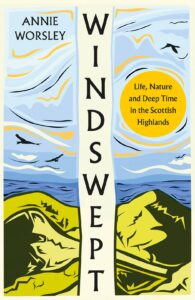In an extract from ‘Windswept: Life, Nature and Deep Time in the Scottish Highlands’, Annie Worsley finds lost landscapes, precious gems and resilient salmon in the waters of the Red River.

Autumn
Peter’s fish survey discovers a salmon in the Red River (Abhain Dearg)
Later that day I walked downriver, happy knowing the waters of Abhain Dearg were providing for the young silvery salmon. Where the waterfalls meet the sea is a shingle beach whose large rounded stones and boulders get piled high into giant steps by powerful winter storm waves. It was busy with oystercatchers and ringed plovers. The salmon must have negotiated the stepped sandstone, the tumbling waters and pebbles churning in the breaking waves. Often at sunset, as water pours down from the croft, it takes on the colour of old blood and the waterfall’s rock steps deepen to rust and bronze. Here and there small patches of rosy sand caught the late afternoon light. Larger boulders shimmered like armour dropped by warriors in ages past. The shiftings of smaller pebbles and stones vibrated and slurped westwards. It is a secluded and contemplative place, set apart from the business and activity of people. Rewilded remnants of past lives are scattered about, old tyres with myrtle or willow growing in their centres, logs covered by moss and winches studded with rust and barnacles, old stone walls coated with pink thrift and furred with grey lichen. Nearby I spotted a rock slab with rippled surfaces created by the action of small waves passing over sand grains billions of years ago and then frozen in time. I sat down on one of the waterfall’s steps and through the clear red-tinted river water could see the same kinds of ripples in the bottom sediments, with similar dimensions, amplitude and length as those of the Precambrian. Both sets of ripples were at once endless and timeless, twins created by the continuous movement of water across sands. The Red River seemed to arc into the Archaean and pull lost landscapes out like teeth.
I thought again about the salmon, of how she had to cope with the raging torrents of a river in full spate or how, after a prolonged period of low rainfall, shallow trickles of river become molten metal slick, when gabbles of water bubble and shimmer across gravel banks and pierce the gaps between boulders, and when precious gems appear to be resting on the riverbed, highly polished and ready for sale – garnet, jade, malachite, amber, jet, sapphire, topaz and diamond. I wondered how any fish could survive such a low water level but remembered that Peter had reassured me. ‘They will always find a pool somewhere, underneath overhanging vegetation or beside a boulder, which is why rewilding your riverbanks is so important,’ he had said.
But on that evening, as the Red River cascaded down the waterfalls, it trilled in harmony with a sea chorus of brine-slosh over beach cobbles. It seemed that one was calling out to the other, and as the music played and waters sparkled, their laughter bubbled with earthly magic of the purest kind. I knew it then to be a salmon river, with wriggling eels from the Sargasso Sea and colour-changing trout. I realised too that Abhain Dearg is also a light-catcher and sound-bringer, carrying ideas and stories out to the west along with its sediments. The sea must be plankton-full of them.
*
‘Windswept’ is out now, published by William Collins. Read Kirsteen Bell’s review here.